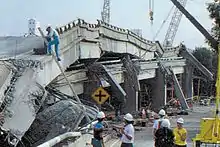Buried rupture earthquake
A buried rupture earthquake, or blind earthquake (c.f., surface rupture earthquake) is an earthquake with non-visible offset of the ground surface when an earthquake rupture along a fault does not affect the Earth's surface. See also blind thrust earthquake, a close concept.


Ground motion
Recorded ground motions of large surface-rupture earthquakes are weaker than the ground motions from buried rupture earthquakes.[1]
Depth
The asperity for a buried rupture earthquakes is in area deeper than roughly 5 kilometres (3.1 mi). Examples are the Loma Prieta earthquake, Northridge earthquake, and the Noto Hanto earthquake.[2]
Tsunamis
Uplifted water outside the fault plane in the buried rupture case, as compared to the seabed surface rupture case, makes for large tsunami waves.[3]
See also
References
- "OBSERVED DIFFERENCES IN GROUND MOTIONS" (PDF). IJR. Retrieved 30 October 2018.
- Wada, K; Goto, H. "Generation Mechanism of Surface and Buried Faults Considering the Effect of Plasticity in a Shallow Crust Structure" (PDF). iitk.ac.in. Retrieved 31 October 2018.
- Goda, Katsuichiro (October 2015). "Effects of Seabed Surface Rupture Versus Buried Rupture on Tsunami Wave Modeling: A Case Study for the 2011 Tohoku, Japan, Earthquake". Bulletin of the Seismological Society of America. 105 (5): 2563–2571. doi:10.1785/0120150091. hdl:1983/ab80d036-71a5-45e6-a26c-180964d589f4. Retrieved 29 October 2018.